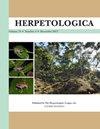Movement, Home Range Size, and Habitat Use of Eastern Black-Tailed Rattlesnakes (Crotalus ornatus) in the Northern Chihuahuan Desert
IF 1.1
3区 生物学
Q2 ZOOLOGY
引用次数: 1
Abstract
Abstract: Despite its wide distribution throughout the northern Chihuahuan Desert, extraordinarily little is known about the ecology or behavior of Eastern Black-tailed Rattlesnakes (Crotalus ornatus). The primary literature for Black-tailed Rattlesnakes was largely based on research conducted on the former conspecific (C. molossus); thus, the revalidation of C. ornatus widened the void in our understanding of the species. The aim of this study was to elucidate movement patterns, home range size, and habitat use by C. ornatus in the northern Chihuahuan Desert of far West Texas. Radiotelemetry was used to monitor individual snakes for at least one active season (March–October) from May 2015 through August 2018. Mean (±1 SE) home range size for all individuals was 22.84 ± 4.49 ha and mean daily distance moved was 9.28 ± 0.93 m/d. Male snakes had larger home range sizes, larger core use areas, and greater daily distance moved than did female snakes. On a monthly basis, male movement peaked in August and female movement was statistically similar throughout the active season. Multinomial logit models were used to analyze habitat use patterns of C. ornatus, while controlling for snake, habitat availability, and season. Despite limited availability within snake home ranges, most observations of snakes occurred in arroyos or on rocky slopes. Microhabitat was also used nonrandomly, with snakes seeking cover in rocky refugia or under dense vegetation, rather than in areas containing high proportions of gravel or plant litter. This study presents the first detailed information about habitat and microhabitat use, along with patterns of movement and home range size for the recently revalidated C. ornatus.奇瓦瓦沙漠北部东部黑尾响尾蛇(Crotalus ornatus)的运动、活动范围大小和栖息地利用
摘要:尽管东部黑尾响尾蛇(Crotalus ornatus)在奇瓦瓦沙漠北部分布广泛,但人们对其生态和行为知之甚少。关于黑尾响尾蛇的原始文献主要是基于对其同种(C. molossus)的研究;因此,该研究拓宽了我们对该物种认识的空白。本研究的目的是阐明C. ornatus在遥远的西德克萨斯州奇瓦瓦沙漠北部的运动模式、家庭范围大小和栖息地利用。从2015年5月到2018年8月,无线电遥测技术用于监测至少一个活跃季节(3月至10月)的单个蛇。所有个体的平均(±1 SE)居住范围为22.84±4.49 ha,平均日移动距离为9.28±0.93 m/d。雄蛇比雌蛇有更大的活动范围、更大的核心使用区域和更大的每日移动距离。按月计算,雄性的活动在8月达到顶峰,而雌性在整个活动季节的活动在统计上是相似的。在控制蛇类、生境可利用性和季节等因素的情况下,采用多项logit模型分析了红草的生境利用模式。尽管蛇的栖息地有限,但大多数蛇的观察发生在阿罗约或岩石斜坡上。微生境的使用也是非随机的,蛇在岩石避难所或茂密的植被下寻找掩护,而不是在含有大量砾石或植物凋落物的地区。本研究首次提供了关于栖息地和微栖息地使用的详细信息,以及最近重新验证的C. ornatus的运动模式和家庭范围大小。
本文章由计算机程序翻译,如有差异,请以英文原文为准。
求助全文
约1分钟内获得全文
求助全文
来源期刊

Herpetologica
生物-动物学
CiteScore
4.60
自引率
0.00%
发文量
27
审稿时长
>12 weeks
期刊介绍:
Established in 1936, Herpetologica is a quarterly peer-reviewed journal serving herpetologists, biologists, ecologists, conservationists, researchers and the scientific community. The journal contains original research papers and essays about the biology of reptiles and amphibians, and covers many relevant topics including: behavior, conservation, ecology, genetics, morphology, physiology and taxonomy.
 求助内容:
求助内容: 应助结果提醒方式:
应助结果提醒方式:


